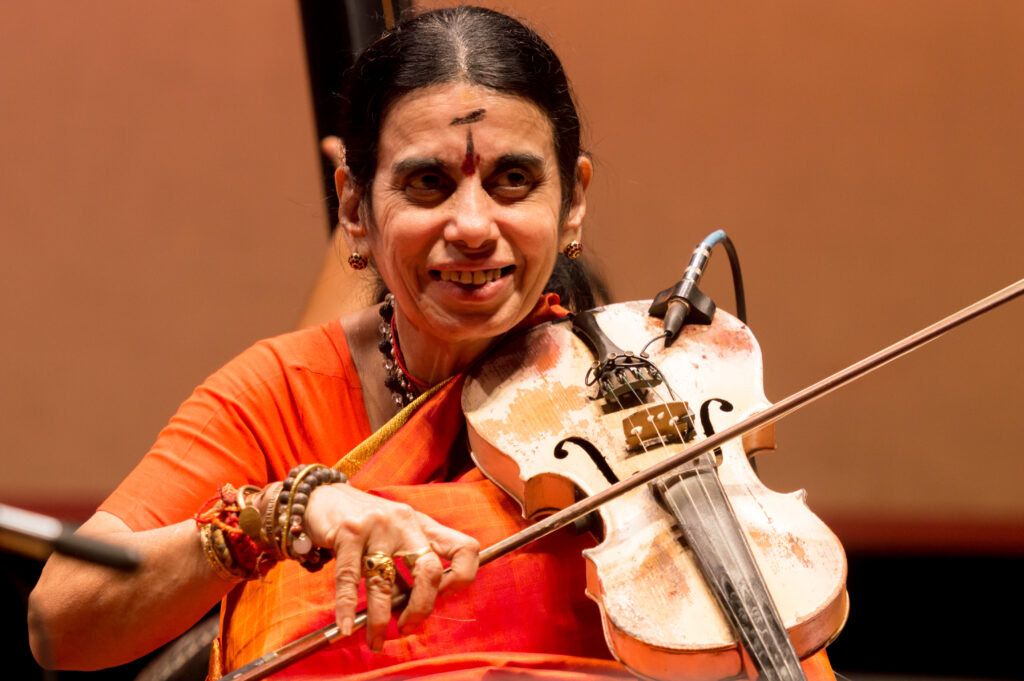A. Kanyakumari’s Ekaika rAgam Project
Last December, violinist Sangita Kalanidhi A. Kanyakumari began a thematic series to showcase Thyagaraja’s Ekaika rAgam-s – those in which only one kriti is thought to exist. She began on Friday, December 13th, 2019 with E dAri sancarintura in the rAgam Srutiranjani. She had envisioned it purely as a three-week project for that music season, but the excellent response made her keep at it – so far 49 rAgam-s and kriti-s have been premiered – one each Friday.

“I wanted to do something thematically, hitherto not done,” she explains. “Thyagaraja, as a composer, has maximum appeal – the lyrics are simple and comprehensible and the music accessible.” That instrumental music is not given its due in the present day was also an issue she wished to address with this project. “nAdam comes from instruments – the tanpura too is used for nAdam. The lyric can be faithfully replicated in instruments while conveying the appropriate bhAvam as well. Instrumental music should be on par with vocal. Instrumentalists put in a lot of effort into their art and they should be given their proper due.”
A version of this article appeared in the The Hindu. My sincere thanks to Sri. L. Ramakrishnan for his invaluable assistance and to Sri. R.K. Shriramkumar, Dr. Sumithra Vasudev and Dr. R. Hemalatha for technical clarifications.
Besides being a reputed violinist herself, Kanyakumari is a renowned and effective teacher who has consistently brought forth respected performers to stage. Her rationale in the selection of the pieces, and the order of presentation, reflects this understanding of various age groups, levels of musical competence and attention spans: “I began with catchy rAgam-s to pique interest. One cannot present exclusively rare songs or only vilamba-kAla kriti-s. If we force beginners to learn larger chowka-kAla kriti-s, they will get disheartened and lose interest in the music itself. There is immense variety in Thyagaraja’s compositions. ramincuvArevarura in supOshini, for example, is composed in a Western style, in a fast tempo, but with a simple unornamented structure that allows even beginners to learn it. This type of kriti can also be sung in a group. Then there are heavier and slower kriti-s. It is important to vary the offerings, playing popular pieces, rare songs, fast and slow tempos etc. to cater to every type of learner and enthusiast,” she says.
She began by going through the vast repository of Thyagaraja’s compositions, listing out Ekaika rAgam-s, and has gathered 134 “so far.” While she knew some of them already, she had to learn others herself first. For that, she listened to recordings of yesteryear stalwarts and, wherever possible, of multiple artistes. She says that most of the composer’s pieces are easily comprehensible. (The fact that Telugu is her mother tongue is also advantageous, allowing her to thoroughly assimilate the meaning and convey it appropriately.) She then sang each freshly learned piece herself several times, melding it to her style, and setting some sangati-s if they seemed appropriate, all the while keeping in mind the sanctity of the lyrics and adaptability for both vocal and instrumental music. Only then did she attempt playing it.
She has been assisted significantly in this endeavour by her disciples Vittal Rangan, Sayee Rakshith and Mallajosyula Srikanth who, besides playing alongside, have also helped with producing the finished audio. Others who have provided instrumental support are her disciples – vainika Mudikondan Ramesh, Embar Kannan and L. Ramakrishnan. Shilpa Venkatesh, also a student, has handled the video processing.
Contrary to what could be assumed, only solitary pieces are available even in some common and popular rAgam-s like Abheri, Bahudari, Brindavana Saranga and Hemavati, she explains. There are other rAgam-s which are very rare, so rare that no other composer has composed pieces in them – rAmamanohari (to be distinguished from ramAmanohari, a rAgAnga rAgam in the nomenclature followed by the Muthuswamy Dikshitar parampara), GunDakriya and even supOshini are in that ilk. Kanyakumari remarks on how Thyagaraja still so successfully brings out the rAgam essence and bhAvam even in these kriti-s. She also noticed appropriateness between the rAgam-s selected by the composer and the lyrics of the kriti. Of course, she stresses that how the musician renders this is a key part of conveying the message the composer conveys. She gives the example of the piece nEnendu vetukudura – where Thyagaraja laments on where he would search for his idols that have been thrown away, “That emotion cannot be conveyed if played in a fast or aggressive manner – it should be rendered with the appropriate pathos, lingering as needed.”

She concludes – “I hope to continue the series as long as I am physically able to. I will also be releasing the notation for all the songs which should make it even easier for students to learn. I hope this serves as a resource through which more songs and other facts about Thyagaraja can be learned. Everything will be publicly available.”
The kriti-s from 1-100 premiered so far (List courtesy Ms. Shilpa Venkatesh):
So beautifully written about A Kanyakumari Madam. What a musician she is! Blessed to hear her play …she has produced so many disciples and shares her knowledge magnanimously. God give her good health and happiness. Thanks much for this piece.
Thank you for reading and for the kind words.